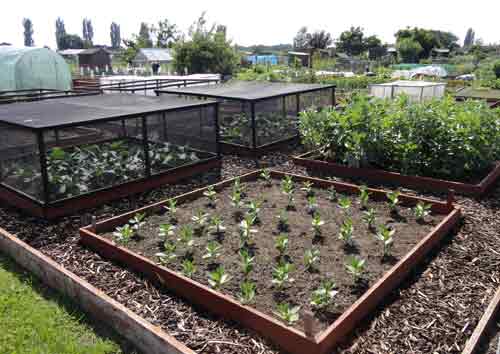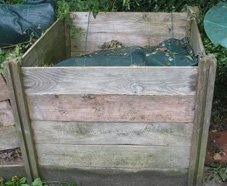Growing an Organic Garden
- some popular methods
This page is mainly about different methods for growing an organic garden. Here are also some of the benefits, too, but I will not talk at any length about most of these as they are dealt with elsewhere on the site.
Organic gardening methods have emerged from the long centuries of traditional growing methods. However, we also have the many benefits of modern science at our disposal, too. Scientific methods have made a huge contribution to the understanding and efficiency of organic growing methods.
Some of these scientific methods can help us at home, whether we are growing an organic garden just for pleasure or as a serious addition to the family finances – in the guise of edible crops.
Advertisements
Raised bed gardening

Raised beds have advantages for the serious grower and the hobbyist alike. Here are a few of the advantages they give us.
Raised beds enable you get up close to plants without needing to trample down the nearby soil. Most raised beds are just so wide that access is always possible from walkways. This is important because trampling around plants compacts the soil and makes it harder for the plants to get the nutrients they need through their roots.
Raised bed gardening allows a lot of environmental control. It is relatively easy to cover plants in a raised bed. Weed control is easier, too. Soil fertility can be more easily enhanced and maintained with composts and mulches. Pests and diseases may be easier to spot and treat. Crop rotation is perhaps easier, too as beds are well defined and can be named or numbered.
Raised beds are suitable for vegetables and salad crops, as well as flowers, herbs and small shrubs. Smaller raised beds act very much like containers; watering and adequate soil nutrition are needed, as the resources provided by the bed may be limited. Raised beds may be open to the soil below or enclosed (just as with container gardens). The latter may be suitable for installing in small backyards where there is little available soil. This can be a good approach for people living in urban areas, where backyard space is limited.
Even on allotments and in large gardens, raised beds can have their benefits. Conventional edges to beds can easily disappear under weeds as the growing season progresses, especially if you, the gardener, do not have as much time as you need. All the insects and pests have an easy access to your beds and from bed to bed. Pernicious weeds such as couch grass or brambles can (almost literally!) walk in from nearby untended ground. Raised beds provide a bit of a barrier, especially if you also use netting as well.
Raised beds also let you extend the growing season because of the extra protection given by the surrounding timber or brickwork. You can use extra insulation to start crops early or keep them going late in the season, much as you would with containers or cold frames.
Raised beds can be anything from a few inches higher than the surrounding ground to waist height or more. Growing an organic garden becomes possible for those who are confined to a wheelchair or other people with limited mobility.
Advertisements
Square foot gardening
One modern innovation is square foot gardening. This method simply divides the available growing space into a grid of squares of about one foot long and wide. Each grid square is then planted with different crops, in a way that allows them to grow harmoniously together.
Square foot gardening gives you 100% of the crop in 20% of the space, according to the founder, Mel Bartholomew. It should save you not just space but time and money, too.
Most of the growing takes place in just 6 inches or so of soil. Actually, it is not just soil; it is a special mix of peat moss, vermiculite and compost.
Is it a perfect organic and eco-friendly method?
Growing an organic garden this way is fine if you are mainly interested in quick, inexpensive crops. The website advocates the use of peat moss and vermiculite, neither of which are ideal products from a green perspective. Vermiculite is a mined substance that holds water particularly well. Some vermiculite has been contaminated with traces of asbestos, though this should now be less of a problem. Peat moss extraction has caused a lot of environmental damage in Europe. There are moves to make it more eco-friendly. Here in the UK gardeners are urged to use alternatives such as coir.
See this article in The Ecologist for more on making peat moss more sustainable.
There are grids that need to be bought or made, too, adding something to costs and use of resources.
However, the system should enable you to grow more for far less input and cost. If you have tried square foot gardening, share your experience with us. Just use the Add Your Tips form – at the top of the nav bar.
Mel Bartholomew, the founder is now using his growing system to help end world hunger: www.melbartholomew.com/
Permaculture and the organic garden
Permaculture is becoming increasingly popular as a method of growing an organic garden that is both easy to maintain and a delight to live with.
Permaculture just means “permanent culture”; in other words, methods are used to ensure that the garden mimics nature quite closely in order to create a harmonious whole that is low on inputs of all kinds, especially work.
Anyone who has created or maintained a large garden will know just how much work can be involved. Permaculture methods allow us to cut the workload down to size and ensure that the garden fits in with our lifestyles.
Here’s a very brief look at how it works
Planning and design are at the heart of any Permaculture project.
Different zones are created for different purpose. For example, salads and herbs are usually grown really close the house (zone 1) so that they are easy to access and maintain. This is because they are usually needed on a daily basis.
The zoning system also makes use of the natural contours and features of the land. Plants are chosen to fit with the natural features, too. Dry, arid areas are made use of by choosing plants that will easily thrive in those conditions. This is something that any good gardener will do, of course. Permaculturalists make it into a high priority.
On the other hand, some attention is given to the wanted outcomes or needs of the gardener. For example, a dry area might be improved by structural alterations that allow rainfall to stay longer in the soil.
Permaculture is an eco-friendly enhancement of ordinary organic techniques. The need for inputs is cut drastically by the use of nitrogen fixing plants as well as composts and mulches.
It is also a good system if your garden needs to be highly productive as it uses all the available space, including the vertical space. Orchards become forest gardens, where the layers of a natural forest are copied for maximum yields. Low growing plants can be selected for the spaces between trees, either to provide fertility or to deliver additional crops. Flowerbeds are often interlaced with edible species, including some plants that others might consider as weeds!
Permaculture design courses are now cropping up all over the world. If you would like to know more: www.permaculture.co.uk/what-is-permaculture makes a good place to start.
Advertisements
Companion planting
All the above systems of growing can use companion planting as part of the method.
Companion planting is simply choosing plants which grow well together.
The reasons they grow well together are many; they could attract beneficial insects or deter hostile ones, they could provide shade or protect against other types of disease.
Companion planting offers a simple way to enhance your crops and create a harmonious garden where pests are less of a problem.
Growing an Organic Garden - top of page
Organic Gardening
Greenfootsteps Home - for more easy green living ideas
Growing an Organic Garden
Copyright Greenfootsteps.com 2013
Please do not copy without permission, except for personal use.
| Tweet |

| Tweet |

Sponsored links
Other pages which may interest you:
Why Organic Food is Best All Round

Footprints
- an occasional e-zine from Greenfootsteps
If you would like to receive the e-zine, please just sign up below.






New! Comments
Have your say about what you just read! Leave me a comment in the box below.